|
|
Post by 4real on Oct 23, 2011 23:24:11 GMT -5
Hi there fellow nutz'ers Many here will be familiar with my latest project full of 'innovative' features as I reinvent the solo guitar in various ways... guitarnuts2.proboards.com/index.cgi?board=wiring&action=display&thread=5970One of those features I feel deserves it's own thread as it is a very exciting proposition with huge potential for many in the right hands. It would be nice if people were to give credit where due if the ideas are used and link back here and to share what they make with the basic ideas and improvements in the 'open source' manner I am offering it. Just the idea of it in recent weeks has garnered quite a bit of interest across a number of areas and now is a good time to start documenting the idea and the progress. Unfortunately, this is my second attempt at this, firefox crashed and lost everything suddenly just before hitting enter...so I may well start with consecutive shorter posts to this thread... so let's do that... |
|
|
|
Post by 4real on Oct 23, 2011 23:51:25 GMT -5
Ok... So the idea was in part inspired by the original early mid-seventies Roland guitar synth guitars, the GR500...though I believe I may have seen similar things also back then. A lot has changed in recent times, but the idea is certainly sound and suitable for the DIY'er and extremely cost efficient if this HEX capacity is something that you desire. 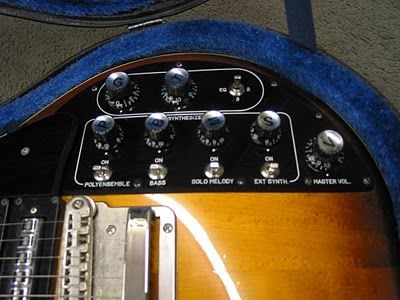 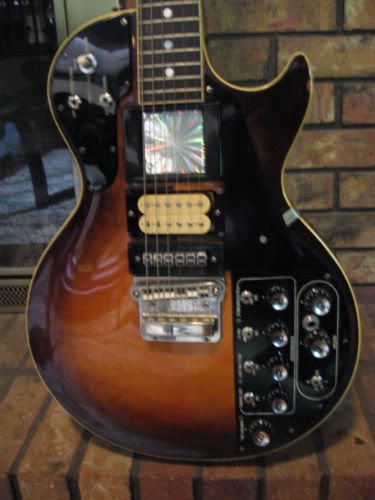 I am also drawing on my HEX sustainer work of many years ago, so I do have some experience with this kind of thing and had done some preliminary tests with some of the concepts at work and knew of the potential there. ... Cassette Tape Heads A PickupsHere is a pic of what is inside a typical simple tape head...  from en.wikipedia.org/wiki/Tape_head which will offer more information on this aspect of the things. Like most electromagnetic devices, it consists of a coil. In this application, unlike conventional guitar pickups, they coil is going to be across the string. It is obviously a small coil and so therefore low impedance and to drive amps and such, will require a pre-amp at least. It is also designed to read things very close to it, the tape is after all touching the head. The reading/sensing part is tiny, perhaps 2mm so needs to be aligned carefully and wont cope well with a wide string vibrations. ... All these points are ok if like similar hex midi devices, it is made to be extremely close to the string and to the bridge saddles. This is where vibrations are smaller (being zero at the bridge break over point) and so you can get the device very close before the string can hit it (particularly a problem with bass strings which have a wide arch of vibration nearer the centre of the string). It is also a place where there is a lot of complex harmonics going on. This is a dual edged sword...potentially a very rich sound, but if used in say a midi application, will likely need to be filtered and possibly compressed to get a clear bead on the fundamental. In other applications, perhaps such harmonic complexity is desired, think of the complexity in the higher orders in say a piezo system reading from the bridge saddles themselves. But simple filtering and such can all be achieved, especially since some kind of pre-amp is going to be a necessity. Further, once the signals are out of the guitar, the world is your oyster as far as processing and modelling is concerned. Think of such instruments as the Variax which uses a hex piezo system as the source. Think of the power in even cheap digital effects available now, and many of us will own. ... My simple application of such a deviceIn the project I am working on, I am not being too ambitious and working within my capability and knowledge to maximise success, others with advanced skills in electronics could certainly improve things and find new directions, people with such skills and programming ability, could go berserk with full on midi capability I am sure. For my project, the aim is to get a good separated signal from each string that can be modelled out of the guitar in various ways. As I have become involved with the solo guitar and building a unique speciality instrument and arranging for that, I got to thinking, it would be cool if I had a pickup for just, say, the low E and A...run that through a harmonizer to an octave below, and so create a bass line that follows the notes played on those strings. Of course, with such day dreams, you think...hmm, perhaps I only want the E string some times, perhaps I want the lower three strings... It is only a matter of time before one things...hmm, perhaps I'd like to do an octave up on higher strings (getting a mandolin/12 string kind of effect), perhaps delay only the top strings so the bass line is tight and not delayed. Perhaps, I want to run the top two strings through my sitar simulator and play Norwegian Wood...perhaps I want an auto volume with delay and chorus on the higher or mid string to create a kind of string pad effect behind the guitar notes...perhaps... You get the idea...so... A pickup that can select a separate out of what ever notes I might seek to process through a separate channel, at least, is required...to do that you need at least some kind of sensor for each string... |
|
|
|
Post by 4real on Oct 24, 2011 0:19:39 GMT -5
So quite a bit of research and lateral thinking got me... A cheap supply of new cassette tape headsNeeding six identical heads and that others will want to replicate this idea and build on it (there has already been a bit of interest), hacking old recorders is not very efficient or a likely solution But...it occurred to me (as I have one in my car) that car cassette adaptors are relatively cheap and pretty much only have this part in it...searching eBay, I did not realize quite how cheap...as low as a dollar! 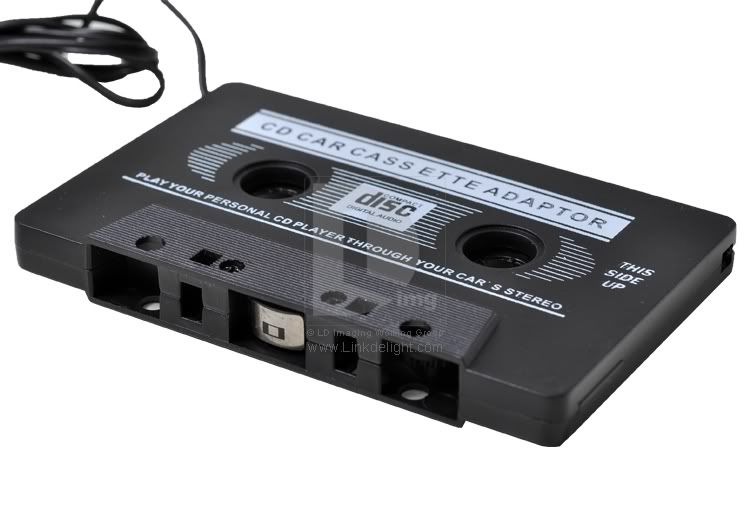 I ordered a set of 6 and they arrived today...more on this later... As you can see though, there is a basic cassette head in there, easy to access and without waste or expense...so at least worth a go trying. ... Size mattersMeasuring heads around her in my stereo and such, they seemed to be about 11mm wide...this is a big string spread, so designed my guitar to take it under that assumption (plus it suited my playing needs as a wide string spread at the bridge is a good thing for fingerstyle). If smaller ones were required, I know I have seen them, but that may not be my necessity to search them out. ... Ah..but after they arrived I was in for a bit of a surprise, a bit of a bugger for me unfortunately, but some important information and a big bonus for the future. I assumed when I was ordering that the 'black ones' and the 'white ones' were identical except for colour, they have the identical case and printing on them from the same supplier. So, in the mail today I got 4xblack and 2 white...they are not...hmmm....  Not so good for me, but good information for others to know and gives the project added potential for other applications than my idiosyncratic guitar. So, taking apart these things is easy, 6 small screws an out pops a lot of plastic gears (to fool the player that a tape is running so as not to stop or auto reverse), some springs that hold the tape heads in place and softly touch the players heads and that's about it...oh, and the tape head pre-wired to a 'ear-bud like' tiny shielded cable and 1/8" ack socket for your iPod or whatever...the bit we want! 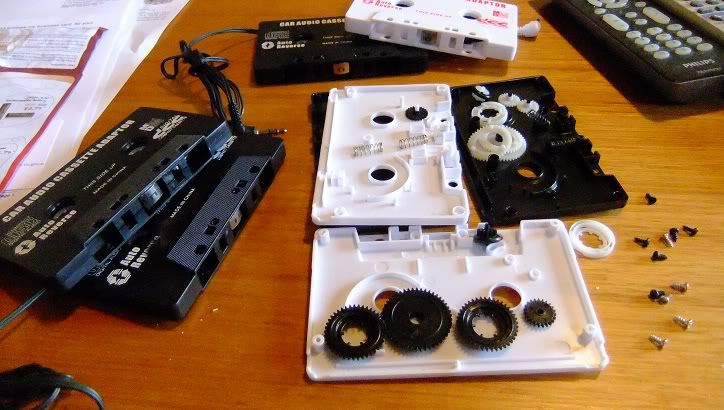 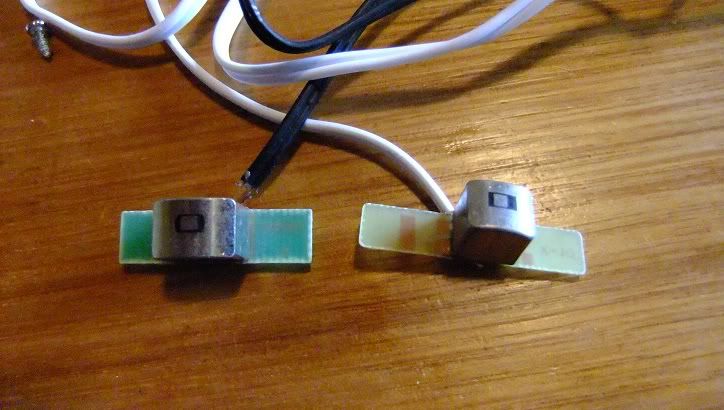 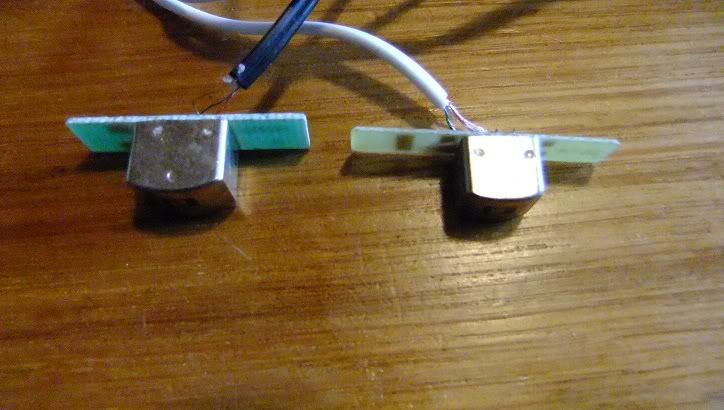 Ok...so the specifications. From my supplier, the white ones were the smaller of the two... Black measure 10mmx7mmx8.5mm deep (plus soldering points) White measure 8mmx7mmx7mm deep (plus soldering points) interestingly...the smaller one read a slightly higher resistance. black 272 ohms white 291 ohms I suspect that this is an average for all such devices and this is just a common variance...not much. For my purposes, I want them to all look the same. It was my 'fault' for making the assumption so have reordered to get two sets of six, white and black...so the mail will again take a few weeks...but that's not too bad, made a discovery there, both are smaller than the ones I had measured with is a good thing (8mm will work on any guitar spread). more to come... |
|
|
|
Post by 4real on Oct 24, 2011 0:45:42 GMT -5
Ok, made a coffee, so ready for the next instalment...
I've outlined the idea above and where it came from. Remember that Les Paul made his first pickup and performed professionally back in the day by sticking a gramophone needle into th top of an acoustic. Or Leo fenders amazing achievements without being a guitar player...those 'blade switches came out of the old telephone exchanges and are still used today in guitars regardless of their original and original use.
I've been criticised by some for not having the qualifications and such to take these things to the nth degree, this is true, but generally, I do get the basic concepts to work and rely on others or modest ambitions within my knowledge, skill set and budget to help out, or to take things further.
...
Crude Test Results
Ok...even though I am quite busy with a few things pressing on me, you know within seconds of getting home I ah these things apart...and being pre-wired, who could resist answering the big question...do they work! I couldn't...so here is a preliminary impression and test for you.
Using a stereo headphone 1/8-1/4 phone adaptor I plugged one intomy fender deluxe amp (ok, so the impedance is all out, but it will make a sound if it is going to work).
The next post will discuss magnets, there are no permanent magnets in this thing and the strings need to be magnetized. My strat however, has 4 sets of magnets under each string (HSS) which will suffice in a crude way.
So, plugging the tape heads in, held above the string and directly over the pickup magnets, and extremely close with the sensing part aligned...this is what I found...
A sound was created and in fact, much to my surprise quite a good one, especially for such a crude test. There was very little noise, even though the strings were not earthed effectively (not being plugged in) and the tone not that bad at all, I was expecting something much worse that would need special filtering and such, but no...not too bad at all for such a test. How they might sound pre-amped and especially very close to the bridge (I could not test that sound yet as there are no pick-ups there).
There was an odd 'wavering to the sound, especially on the lower stings. Where ever I tested the string were vibrating in an arch well beyond the 2mm sensing area of the devices (both are the same size in that dept)...the result was a kind of shallow tremolo effect, not off an on, but significant effect in time with the strings vibration.
This can only be expected and cured by moving close to the bridge where the strings do no exceed this limitation.
The devices needed to be extremely close to the strings, the ability to do this was also hampered by the vibration arch and should be cured by moving close to the bridge and closer to the string. Hitting the head with a string produced the 'clanky' kind of sound one might expect...hit a conventional pup with something metallic and that happens.
Otherwise, as a crude test, more than expected it was a success and bodes well for my application and for future development I would say.
Even the mistake in the order revealed that one can get quite small tape heads easily that will fit conventional string spreads. That the smaller heads perform about the same.
...
These are the absolute cheapest things. The adaptor in my car has what looks like two heads in it (perhaps such a head could be arranged to be HB-ing or double the output) and perhaps a wider sensing area...but then, it is bigger (perhaps the kind of thing that would do better in a bass which has really wide vibration arches).
...
It should be obvious that these devices have no permanent magnets in them, my crude experiment is not the ideal, just a test...adding suitable magnetics to them is vital...so that will be next...
|
|
|
|
Post by 4real on Oct 24, 2011 1:04:47 GMT -5
Ok... MagneticsGot to have a permanent magnet. The tape head is sensing the changes in magnetic strength (just as it does with magnetic tape) as a magnetised string vibrates very near to it...just like the workings of conventional guitar pickup. I have had some experience with these things from the sustainer project, but why not look to see how others have approached it and keep things simple...  This is a hex pup in a "Power Gig" controller for some kind of guitar hero thing, with strings. Notice the bars alongside the conventional coils for each string. Take a closer look at the old roland again...  you might just make out a similar miniature thing on the bridge side of the pickup heads there... ... Here is the way I am proposing to do mine for this project, though I have a few magnets here and various solutions that should also work for a different situation (I have quite a bit of room to play with, so although the finished device will be compact and suit the instrument (one hopes) it is an unusual guitar. So, I had posted this proposal and i think it still stands well as a solution for me in this situation. img.photobucket.com/albums/v248/peterstewartwarmington/jazzstrat/Tapeheadpup01.jpgSo, a steel bar, not mush wider than the sensing part of the tape head, runs up the side and close to the string, a magnet under will magnetise the bar and the lines of magnetism will be attracted through the steel, along the string, and back to the opposite pole below. Being close to the bridge, a more powerful magnet could be used as it is not likely to have anything like the dampening and intonation problems of pickups closer to the neck say. You would not want to get silly with it, as long as the string is magnetised, the head will read it. The whole assembly will need to be very close to the string and the string vibrate over the 2mm sensor...so very close to the bridge saddles. Some might recall this illustration...  which shows that the head has a very narrow sensing range and very little 'throw' beyond the gap. This is not such a bad thing though and to be expected. You do not want your magnetic fields to be attracted to the magnets of other strings or for a sensor to be able to pick up signals from nearby strings at all...just the one, and this is pretty concise, more so than something like a power gig like coil or other 'hex' systems of that nature..plus, no coil winding and so much ceaper...and smaller! Coooool as the youngsters might say...(or is that 'sick'...I'm getting older all the time). ... |
|
|
|
Post by 4real on Oct 24, 2011 1:43:49 GMT -5
For my application, this is to augment as an option the sound of the actual guitar, shadowing strings. Perhaps it could be used on it's own in it's own right now that I have heard the things and with some development. Here is a diagram of my basic proposal 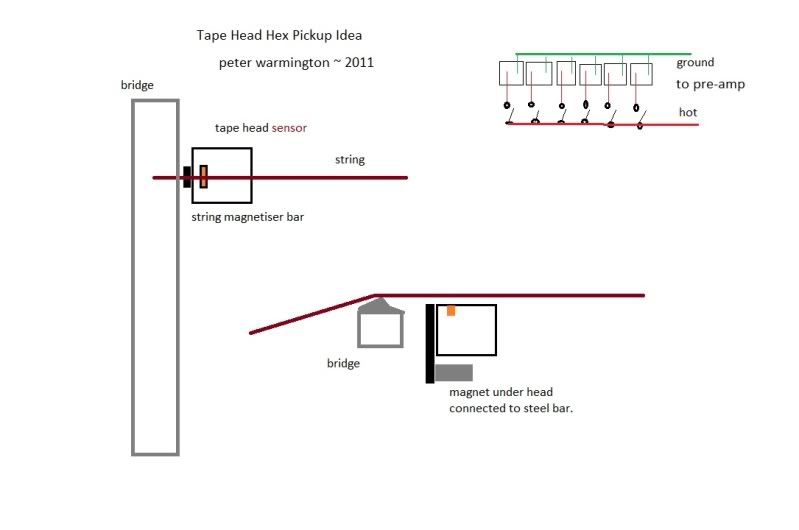 For my purposes, I am thinking the above. Small rare earth magnets attached to steel rods for each, magnetizing the string above and separte from each other. Very close to the bridge and to the strings without hitting each other. ... I have also outlined the silly simple proposal for the way I want to apply these things, as a starter perhaps for things to come. Basically, a separate optional output for this pup array. All will be switchable to a mono output. I am proposing for my project very small DIL/DIP spst things built into the side of the pups (perhaps 3 per side, one for each string if available...or something similar...like this...  or  You select which string are on and sent to the pre-amp in parallel, hopefully there wont be too much volume variation. A master volume for the pre-amp will adjust this and the balance with the rest of the guitar. The resulting output for this will go ot a digial/modeling pedal or oethe effects. This will allow for quite a bit of EQ, compression, NR and other modelling, even amp sims...plus any effects you would choose like pitch shifting or delay and such. ... Obviously, this is the simplest incarnation designed to augment the guitar and it's existing piezo and traditional mag sound. Best to start simple and acually useful. One obvious 'next step' would be to run such a thing in stereo...process two sets of string separately. To do this, you would need to double the pre-amps, volume controls and wires out of the guitar, plus separate processing...doable of course...hmmm Or, go the whole hog, six channels, etc... In fact, with my project I ahve unlimited room in the thing...but that is not the intention and at this stage (unless someone clever had a good audio to midi version that I could build perhaps) that is going ove rthe top and bound to fail through complexity. This is an obvious application though and I am sure there will be someone out there do it and I hope they share all that too... But with midi comes other problems and expense. Latency and the inputs into an audio to midi thing for each string...it will only work as well as the sound module or computer and software to run it. I'd be very interested in being able to write transcriptions directly from the guitar so I wouldn't rule it out, even for myself...but beyond my abilities or needs. When thinking about all this though and looking back into the history. When this idea first started to emerge, they did not have the kind of cheap digital capabilities that are around nowadays and most people may already own. The Variax shows that with modelling, you can change even a piezo system (these sound 'better' than that) through modelling to sound like a Les Paul a strat or a banjo and all points between...but does not do midi (kind of weird that...) As I am aiming to 'support' the sound of the instrument, the quality of the sound is not as paramount as it might be with more elaborate effects that are possible (something others might want to explore, like pitch shifting a string to any kind of tuning perhaps, the possibilities are endless). I was pleasantly surprised though and I think there may well be more potential than I had originally assumed, just by these crude tests. Certainly it validated the concept, picking up the signal from a single string and not the ones next to it, being simple and cheap and locating a ready supply of the components. I will of course add to this thread as I build one of these things and prove the concept, at least in my application. I am confident that this guitar will allow this to be done and endless tweaking without mods yet look 'in keeping' and quite compact. Shame it will need to be so close to the beautiful bridge I just finished... 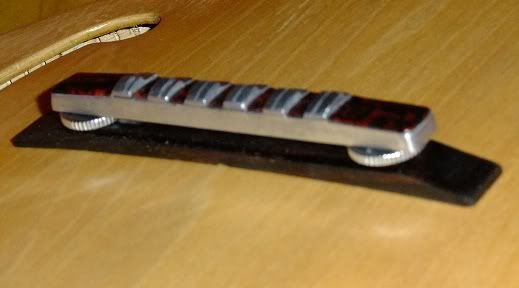 But there is no getting around that really and if I were to make it out of material close to that of the top and such, virtually invisible except for the strip of 7mm wide heads aligned with the bridge...the whole device will be much smaller than the bridge of course, about the width of the HB pickup ring by the looks, including the switching...the mono cable is already catered for to stealth-ly run under the bridge and through the piezo cable hole...an invisible channel already built into the bridge base (like my surface mount sustainer)...plus, the whole can be designed to match the string radius and get close without requiring height adjustment (made with roland pups with shims) and secured with removable double sided tape. ... Ok...so there you are for now...the project still has a lot more to do and this is the last thing in it, but it all looks promising. I have ordered another set so I can have everything match, but I will likely get some time to do some more experiments and testing from time to time before I build the final thing...plus have the parts for a version 2 LOL. Given that they seemed to sound quite good as is, I am feeling more confident in my basic pre-amp choice so that is good too. I know that there will be some interest in this that I suspect will escalate as people run with the idea and apply it to their needs and desires. So, hand it over to the nuts and refer peoplehear who are interested (to save me typing everything again at other forums to promote the idea. For abit though, it will be back to the other thread for the build of the yet to be named beasty...there is a heap of great ideas in that and I am really looking forward to how it turns out and performs. It is going to take a while, I know I will need the encouragement and advice of the fellow nutz along the way, but the while concept is working better than I expected and looking good too and I think, one great 'concept guitar' that many might find aspects to their liking and adapt for quite a while....like this hex system ... Over to you guys till I start building and testing in earnest on the device... |
|
|
|
Post by JohnH on Oct 24, 2011 3:38:32 GMT -5
Great stuff Pete! You probably know best on these kind of things, but without such knowledge, my hunch would have been that the use of an extra magnet to magnetise the strings may not be entirely indespensible. I would have guessed that just having a piece of steel (the string) flapping about above the head would be causing a sufficient "disturbance of the force" to create a signal. " as if millions of voices (well six anyway) suddenly cried out in terror (or at least responded to harmonic vibrations), and were suddenly silenced (or hopefully wern't) John  |
|
|
|
Post by 4real on Oct 24, 2011 4:27:02 GMT -5
Thanks John...there are a few double negatives there, or is triple...hmmm
...
No, magnets are extremely important...just as in a conventional pickup. Not in the very close vicinity of a magnet's field in testing little if any signal was present.
Some magnetics is necessary, not to go overboard with it to effect string vibration but some...a bit more likely more output perhaps...might try an few options to see if it effects the tone and such.
...
I was pleasantly surprised by the tone though, even with this simple test which bodes well. I tired running it through a stompbox as a buffer, but unfortunately, the adapter plug and such seemed to not work...so some wiring there perhaps when I get time.
I had expected an extreme full range sound with a lot of high harmonics and perhaps harsh, but in the standard pickup positions was quite a full sound for such a tiny thing...till will tell how they perform and all, but a good start.
...
Got a few things happening at the moment and the guitar itself is required before this can be done in earnest, but might find time later in the week to explore things further...a house inspection mid week means I have to 'disappear' a few things like guitar building LOL.
...
I've also had some interest elsewhere and directed them to this thread, so we may have some interesting visitors and applications for such a pickup...more than I could hope to achieve on my own.
...
I think personally, that the potential for this kind of thing is enormous for various people and that quite a few variations of things will emerge if done right in a basic form.
So far, it has been an achievement to source something that works at such a cheap cost (AU$8.40 delivered) and there were some wins in finding ones that happened to be smaller than I anticipated and applicable to standard instruments (shame I ended up with a slightly mismatched set so a few weeks anyway to rectify that).
In some ways it is a very different pickup having a coil across the string but I think there are all kinds of applications...with a bit of circuit tweaking, I am sure you could do wonders with a fairly simple pre-amp. So far though, I think even the old PreCHAmp will be adequate for my purposes...at least for a good start.
I know what I am trying to do with it, but there may well be others that go in some really interesting directions. Who knows, perhaps they could be built into a quite valid pickup in it's own right. There are of course many different types and qualities of such things, I've gone for the cheapest and easiest option.
...
I really think that it might suit this guitar project, it would be a shame to clutter things up but I think it will be ok. This guitar is envisaged to have a functional but I suppose 'future-retro (TM)' steam punk kind of vibe in a few ways. The traditional look with the fender head, the mechanical leavers with tortoiseshell appointments on the aluminium bridge, an acoustic guitar made of plastic, a guitar full of pre-amps...and hopefully even a hex option, a row of tape heads appearing out of a wooden enclosure less than 1cm wide!...this is one unique project if I do say so myself...and I just did...now playing the darn thing..ah, but that is for another time!
|
|
|
|
Post by 4real on Oct 25, 2011 21:21:04 GMT -5
Had a little spare time and the soldering iron out today, so was above to separate out the heads from their little circuit boards...these things re mono btw, with the hots of the stereo leads connected to one side, ground to the other...there are probably better versions about which are really stereo and would have two coils in it and might be worth looking for (this appears to be the kind on my better quality car cassette adaptor in my car)....  The reading aperture is bigger (5mm) and stereo...the head like those in my players is 11mm wide (so wider than a normal string spread, but might be good for a bass) but likely has two coils which raises some interesting possibilities perhaps...like a mini HB configuration if one could work out suitable magnetics. This is what is inside a roland GK like pickup as someone revealed recently in this 'hack' photo...  These tiny coils are extremely low impedance wired like an HB with N/S magnet beneath just like a little HB. The tape heads have a bit more impedance than these...but are obviously a bit 'bigger'. ... However, the adaptor used in my car though stereo and better quality probaly cost about $10...six is $60...a lot more than experimenting with the smaller cheaper versions at $6 for a set of 6...so will continue with that. I have ordered some more to get a complete set of the both sizes and will have to wait till they come through to build the complete pickup assembly for my project guitar. Likely I will use the bigger ones as they will fit ok, the smaller ones should work with a conventional electric or perhaps a different version, application or other experimentation later. ... So basically, here are some pics of the heads removed completely to the components...  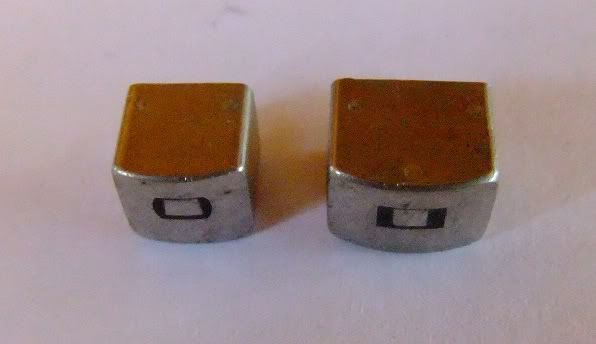 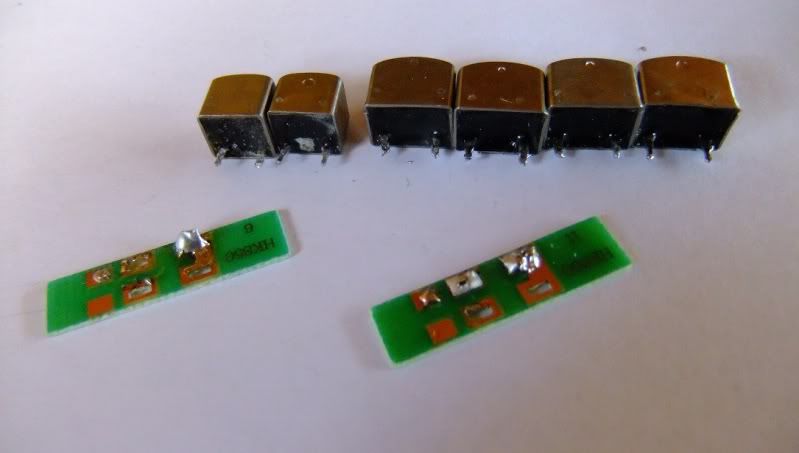  The metal case is and all is encased in epoxy inside and the whole assembly is easily removed. ... 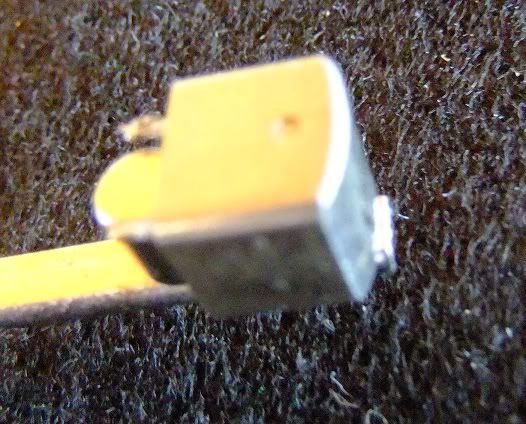 Here is a bit out of focus pic of one way in which you could add a magnet to the things...a small rare earth under with a steel rod running up the side. I found that the metal casing of the heads though are magnetic themselves so some experimentation may find that the case itself might be able to function for the magnetics with some kind of magnet below. There are other options for magnets and many different types available in ceramics at craft shops for instance...Often you can find things in $2 shops and I have a few in a collection and the origin of the magnets in my tele's sustainer driver. I will need a bit more time to experiment with various things and finalize the design, but these things should be able to be made very small. ... But, for some food for thought and imagination and give some sense of 'size'... Here are the smaller heads balanced on the bridge of my strat (note my strat is set for a high floating bridge so fairly high set saddles, still a bit of a neck shim and you would have the same effect on any strat... 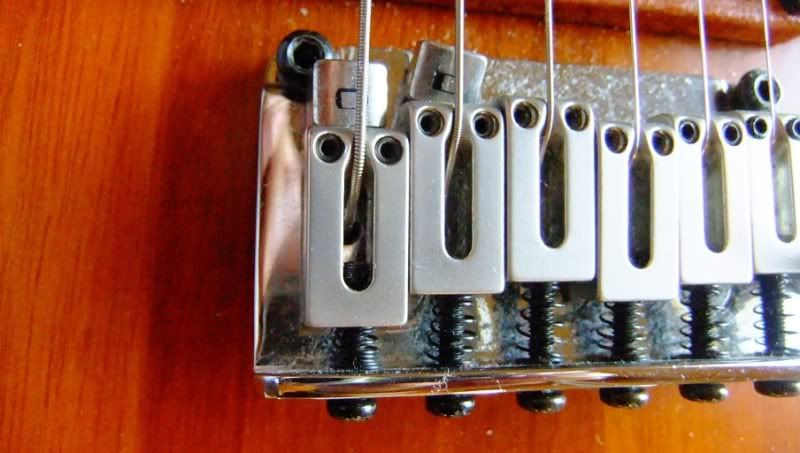 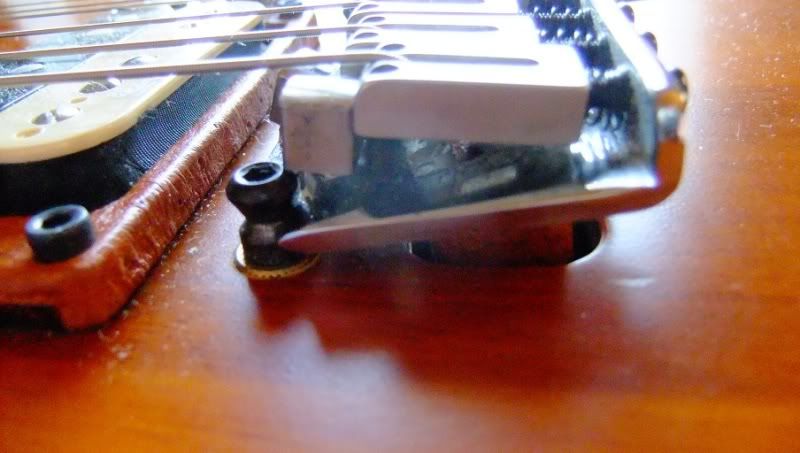 This would be the idea and closer to the string saddle than I will be able to get on my project or even a GK pup. An added bonus, the bridge plate is steel and could help with the magnetizing of the strings and all that side of thing...so could be made extremely 'stealthy' and if someone comes along with some cool midi conversion... Actually possibly if you had 6 inputs into a computer and a program like Reaper with audio2midi software (free) on each channel and driving VST's or the channels combined and saved and brought up into guitar pro for transcription editing...I don't have a six channel interface myself though LOL but perhaps I could record with the hex on one channel driving a VST sampled double bass for instance rather than the pitch shifted guitar sound proposed for live use. Regardless, it can be seen that these things are small and infinitely better than trying to wind one's own miniature coils and cheap... |
|
|
|
Post by newey on Oct 25, 2011 21:31:47 GMT -5
Any idea how much actual winding there is inside of one of these?
|
|
|
|
Post by 4real on Oct 25, 2011 21:56:07 GMT -5
Hi, as noted in a post above... They are sealed in epoxy so would be hard to hack into without destroying them (though absolutely "potted' and shielded) The GK rolands are about 94 ohms as I recall. So, they are not in the 4000K-9000K range of a pickup, so low impedance obviously and recall there is no magnets in them. However, the lace alumitones have only 'one' coil in the design (plus some kind of transformer to make the impedance match so a bit of a cheat there as obviously there are a few 'turns' of wire in the transformer). These things may not be directly comparable with conventional magnetic pickups, the necessity to have the pickup so close to the bridge alone is going to create a very 'bright' sound to say the least. Given that you have to preamp them anyway there is scope to filter some of that out and if driving a modelling box, plenty of scope to EQ, compress, amp sim, effect or tweak the sound to taste. I am anticipating using something like this cheap effect box I have...  AX1G...cheap but some cool effects including pitch bending basic looping and a very nice sitar sim LOL...but of course a lot of NR EQ and other effects to condition the signal from such a thing for my purposes. |
|
popsaka
Meter Reader 1st Class
   I'm tired a'playin' so low...
I'm tired a'playin' so low...
Posts: 87
Likes: 0
|
Post by popsaka on Oct 26, 2011 11:17:11 GMT -5
...I have a couple of old midi pups, -each w/ 6 tiny coils and magnets + the multi-cable and mini din plug/jack idea -but I love your project. Not only is it a great experimental platform (perhaps some sort of 6ch non midi as well?) -but your control panel looks fantastic! BTW, what happens to the signal/tone when you turn the tape head 90º ? (perpendicular?)
|
|
|
|
Post by ashcatlt on Oct 26, 2011 11:55:42 GMT -5
This is quite interesting for a number of reasons.
I'm a little concerned that wiring these in parallel may divide down the output to the point where the signal starts to become unusable. If that ends up being the case you could either wire them in series (shorting the unused coils) or you'd have to have 6 buffer/pres and then mix, then maybe a final mixing amp stage.
Also since you've got individual magnets per string have you considered alternating the polarity of magnet and wires from string to string? This would give some humcancelling when adjacent pairs are selected.
I just splurged on a GK3 so I can finally use my Roland converter box as intended. Might have to look into building a breakout box for it in the not so distant future.
|
|
|
|
Post by 4real on Oct 26, 2011 14:08:04 GMT -5
Thanks for the interest and participation, any questions or thoughts help me think of things to try. Ash... When I originally thought about it, yes I thought about hum-bucking pairs. However, once it got to be more of a full hex thing rather than 2-3 strings, I figured that separation might be an important aspect. By having like poles the hope is that the lines of magnetism will be going through a string and attracted to the magnet of that sensor and not cross over to the adjacent strings magnet and get some 'leakage'. On a conventional HB, the fild is quite contained and you can adjust the device close to the string because the 'throw' is less...the poles of one bobbin attracted right back to their opposite pair. In a single coil, the lines need to go up and right around and there is a lot more 'pull on the strings'. So, the thought was that there might be more separation and throw and less problems without worrying about the HB aspect...but it is something perhaps to consider. My thoughts were that a strat uses up to three coils in parallel without diminishing or creating big jumps in volume when more are added...but I might be missing something there. Hence the volume control for this system to adjust the balance of the pup and to balance the pup against the rest of the guitar is a requirement. ... I am concerned and know little about how the things will work together, there is lot's to learn yet. The parallel thing is the simplest arrangement so perhaps start there to see how it goes. Things might need to be rethought and will need ideas to bounce off to come to a workable solution. Perhaps there might be some weird phasing issues and such when working together. There certainly is a lot of scope for people to go 'nutz' with such a device...separate pre-amps for each string, conditioning for midi processing or breaking out in various ways,,,I'm not looking for an application like this myself... billbax.110mb.com/gk%20studio%20extreme.htmlBut perhaps there are people who might. My particular project has an unlimited internal capacity for stuff to be built into it, so you never know,,,but for now trying to keep things very straight forward and others may well take things in interesting directions. My 'vision' for the kind of application I am proposing is to have the selection of coils within the pickup assembly and to run that signal in mono initially. I can see some potential for a stereo version perhaps, but six channels seems to overburden the intended use for me. As I work with them though, perhaps there will be some interesting data gathered I would assume. ... I'd be interested to learn more about midi and the GK and such systems. The cost of a midi system is prohibitive for me, though it may not be a DIY project quite yet. Having a means to get a hex output that is workable is perhaps a hindrance for some and maybe someone will be able to develop some interesting applications once this aspect is 'solved'. I'd love the capacity to do 'midi' if only for the ability to play in transcriptions, but not at any cost. I am thinking more in the way of a variax, using digital modelling of individual strings (of for my application, individual selected string sets) to get a decent sound without having to deal with latency and ADC and such. The noise does not seem to be much of a problem though, the sensors are pretty closed and small and shielded...but we will have to see what a preamp might bring out of them. Hmm, not explaining my thoughts too well, it is 5:30am here...but if you had reverse polarity pickups between strings, the magnetic fileds will tend to cross over I feel, so that the vibrations of an adjacent string on either side or both, may well be read by the intended sensor as a disturbance in the field and compromise separation and create some 'bleed'...hmmm... ... Pop, hi... I am not sure if you had the coil running along the string you would get much out of it at all. I'll spin one 90 degrees and see what happens. Or did you mean on their 'side'. The horseshoe arrangement the coil is arranged on means that only at the sensor or gap is there the possibility of sensing anything, and only thin in very close proximity to it. I'll give it a try though. It would reduce the sensing area on these things from 2mm to 1mm and that might be a little low. Recall I was already getting 'wavering' in my crude test as strings vibrated further from the sensing point. A two edged sword, good separation, but alignment critical. As you move towards the bridge saddle and the strings 'zero point' of vibration, the signal will be less strong but separation and keeping things in line will be a lot easier. Still, you might have something there and there is room to 'spin' them, so will try and few tests on that, thanks. ... It is an interesting concept and I really want to be able to make this or something like it work to achieve the musical aims there. One day perhaps, and if they weren't so expensive and require so much gear, I'd be looking to have some kind of midi kind of thing, triggering samples of a string bass to follow the guitar say rather than pitch shifting but the complexity, expense and such kind of leaves me behind and would be hard to compete with what is out there I would think. There is a lot to be seen though...I'll tinker here and there while waiting for the matching set to arrive and build something more to the concept for my application...the thing really needs the 'host guitar' to be finished and there is a quite a bit to do there first. One of the reasons I am putting in the effort to get that moving along faster than usual. ... In principle though, I think the general idea is sound enough, but perhaps people can see problems that will mean less 'error and trial' for me in the process of developing it. The magnetic aspect is still a little loose, perhaps magnetizing the enclosure will be enough since they appear to be magnetic, perhaps I will be able to simply point a magnet directly at the string next to the sensor...I will try various arrangements and options. When designing the various Hex sustainer's way back, these were all similar 'problems'. In this case each coil was putting out quite a bit of power and it seemed separation was going to extremely hard unless you had something that alternated drive between string and that was perhaps going to far for the benefit. There may well be odd phasing effects with the coils arranged as in the manner here, there were some very weird effects with such arrangements with the sustainer project, such as driving harmonics everytime you bend the string...cool in some ways, not actually what I was hoping to achieve...rwrp pairs cancelled out the drive altogether in such arrangements. I wasted a year pursuing that kind of thing and want to avoid that in these experiments, reach a modest goal, and hope others make more of it or show a way forward in other ways and applications for the concept. This is experiment in real time, so anything could go wrong, However, there is reasons to be cheerful about it with the devices at hand only a few days. We have the precedent of roland's early guitars, we have established a ready supply of such components at a cheap cost and little hassle, we have established that you can indeed get a signal out of them. Getting a decent 'non-wavering' signal that makes for good audio processing with the minimum of electronics, switching between sensor combinations, serial or parallel, filtering that might be required when close to the bridge, separation/interference between strings...all this is yet to be discovered. If all fails, well there is always the option of winding coils and such in a more traditional kind of way, but it would be really nice to avoid that and make the construction of such a device easy and approachable so that more people might play with the idea and come up with their own ideas for hex applications. As I say, my application and ambitions are i think 'modest' compared to what might be done, but it is the 'icing' on the cake to a bigger vision on the whole project. Might be a nice thing to do and a perfect platform and application for it, but not the be all and end all nor something I would be envisioning using a lot. I've already been thinking about amplification and leads from the guitar, having three quite different pickup systems may require triple amplification or a PA to run it, not something I'd be wanting to drag around to play a tune. I only have two inputs into my recording software so recording all three is not really practical. Once you start expanding the idea to cope with this, the cost and equipment goes up a lot...and you may as well get a GK roland system that works! However, my old gigging rig is still here that has a big 15" bass box and aluminium coned 12" that could well cope with the extended range and piezo aspects fairly well. I also have a little 8" ported speaker 15 watt two channel busking amp that can run a few hours off of batteries, and it may be that this is the kind of thing that I may be forced to use in some 'work' and be very portable...so I ahve to keep in mind the entire project and what I am intending to do with it, the hex thing is just an added idea that I thought might be a cool capability to have and others might do great things with the 'technology' if it were shown to work in a simple way. |
|
|
|
Post by 4real on Oct 27, 2011 23:19:41 GMT -5
Hmmm...trouble in Hex land...and life generally this week...
I tried hooking up a basic preamp to the things nad that helped but was still getting this 'wavering sound'.
Thinking a bit further I wondered if it were more than the strings vibration or that the string needs to be incredibly close to the pickup (practically touching) and at the bridge, the movement and so signal is greatly reduced.
Just to answer some questions, it produces no sound if alongside the string, some sound without a magnet (thought there is some magnetism from the existing pickups in the string) and much more of a signal with a magnet.
Locating the magnet on the bottom of the case looked really neat...alas, the sound was still wavering and not that strong...these ceramics though were ideal for the application...but if it does not work well...hmmm
So, did a bit of lateral thinking...perhaps some might put their minds to this. The coil is at right angles to the string...hmmm. Perhaps it needs to be magnetised opposite on either side of the string. Putting two separated magnets pointing at the strings and attached to the pup, but of opposite polarity, appeared to help with the wavering. Boosting the signal seemed to create a bit of noise (hiss) and boosting again through a stomp box even more.
So, I will tinker a bit more but perhaps these particular heads or arrangement is beyond the ability to get a decent audio. It could well be enough to get a decent enough signal for a midi system to get a fix on the pitch and amplitude, though the noise might confuse matters.
...
So, could be fatal to the idea or put things back a bit if I don't think of something there.
There are alternatives though, I was wondering if anyone had considered using 'hall effect' devices to read a strings vibration for instance?
There is of course the option of actually winding coils...a bit of work though. Winding cylindrical coils tends to be easier than long coils typical in a conventional pickup, one could even use a drill as a winder relatively easier.
Perhaps there is something to take away from the lace designs, which are effectively one coil and a transformer from what I can see.
Otherwise, there are reed switch coils and inductors and all kind of other things to explore.'
It's all a bit frustrating for m today so will give it a rest, but if the project is going to take excessive time and money, it would be far better off trying to scope a commercial system perhaps or be content without it for this project till a solution is found...
Ah, but I dare say I will still want to tinker with the idea and it does in fact make a sound, which is something...hmmm
|
|
|
|
Post by JohnH on Oct 28, 2011 3:12:45 GMT -5
A few speculative thoughts:
This wavering- what’s it like? I’ve seen strobed movies of strings vibrating and when you pluck a string, the axis on which it vibrates often rotates, from up and down to side to side, over a number of cycles. I wonder if the heads are able to pick up one of these directions but not the other, so that as the axis of vibration slowly rotates, the signal gets weaker then stronger?
If so, would two heads per string at 90 degrees to each other, wired in series, be able to pick up all directions that the string might move and hence not waver? This could be done with one head at +45 degrees and the other at -45 degrees, both pointing at the string.
I see the heads were placed in an orientation as if the ‘magnetic tape’ that they might have been intended for was running across the strings. Have you tried it as if the ‘tape’ was along, parallel the strings?
John
|
|
|
|
Post by 4real on Oct 28, 2011 12:42:48 GMT -5
Yes john, that's the kind of sound and the likely cause...and a potential cure. Hence, tow magnets either side for the string helped significantly, as the string went from side to side (and so opposite ends of the coil/core) the string it self changes polarity and significantly helped the problem. Two heads might help as you suggest, but there is only so much room there. A better alternative and something that perhaps roland used when they did this kind of thing, was to use a stereo head rather than this simple playback device to counteract the effect...or perhaps they only needed a signal good enough to 'read' the pitch and amplitude for synth triggering on these early synths. The noise was also pretty bad, hiss mainly and due to requiring a lot of pre-amping...it was still not enough volume compared to a conventional pickup... Spinning it so that it runs the length of the string created very little signal at all...I imagine that the reading from both ends of the coils cancels everything out.The reading distance from the string is minute on these devices...they are after all supposed to read a tape in contact with them and are so fairly 'self contained' so you need to be extremely close. Moving the device away from the bridge towards the middle of the string created quite a bigger sound...far better signal to noise and a better tone (the wavering was a bit worse) but not really practical as an application and still not good enough and a bit 'wobbly'. ... Shame, cause other than that things were looking good for the things...hmmm 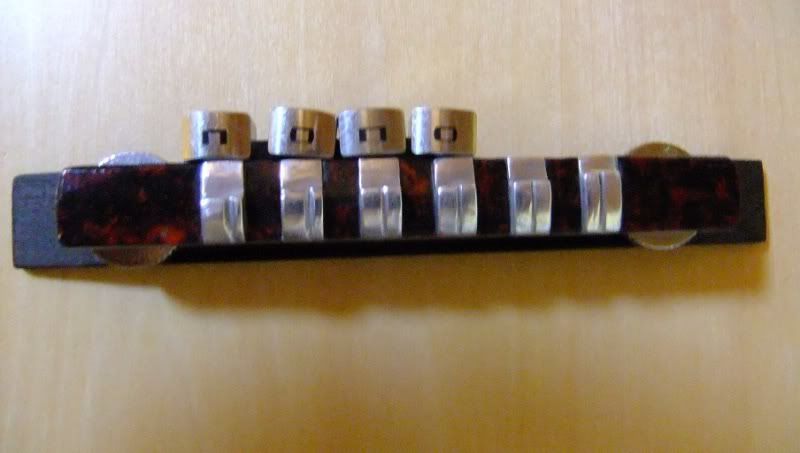  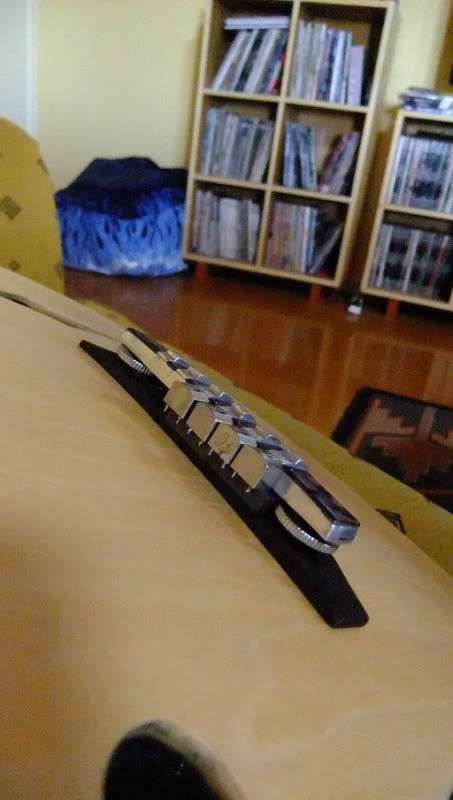 I've got a few thing on and a bit distracted and taking the weekend 'off' so perhaps some 'down time' might yeild some answers...or the brains trust here. ... There are alternatives one might speculate about, perhaps hall effect sensors...and then the less obscure and wind more conventional coils but that is likely a lot of work. Inductors, chokes and the guts of relays and some reed actuators have miniature pre-wound coils in them///but time and expense hacking such things. If I'd not already got a piezo system, potentially, one can cut up piezo discs and get six out of them perhaps (though they are likely to pickup the vibrations of other strings in the body and bridge)...hmmm Or, look for a secondhand roland synth thing which might offer midi capability to generate transcriptions and trigger a synthetic sound and more options. The cost in time and development of novel systems is expensive and as things get more complex and specialized, it becomes less of your average DIY thing really. I am quite enamoured by what such a system might do musically for what I am attempting to do, so who knows, something yet might come to me or will continue to work on things in the background. The guitar project itself seems to be going fairly well, so perhaps when this is finished sans the hex capability, I will have some better ideas or options. Still, you never know, till you have a go and am interested in any ideas that might make such devices a practical proposition, or alternatives that might reach the goals set... |
|
|
|
Post by JohnH on Oct 28, 2011 14:40:35 GMT -5
Still, you never know, till you have a go and am interested in any ideas that might make such devices a practical proposition, or alternatives that might reach the goals set... An aside: These kind of discussions are potentially very creative, and when a problem is hit and everything goes quiet in the room for a few moments, there's a good chance that the right ideas will then follow once the discussion gets going again. I actually have an ongoing side-project at work related to 'where do good ideas come from' I earn my keep from finding good solutions to design problems, mainly in building construction. But the best ideas never come on time, but always later. So I like to explore what it is that makes these ideas happen so we can get to them quicker. What you are doing with your projects, with trying ideas and recording them, presenting and sharing them is spot-on IMO and should result in solutions. Back to the topic, lets generalise temporarily to 'alternative pickups'. There's three ideas that I have thought about from time to time, for hex pickups: String induction - in which magnets induce a signal in the strings, of very small amplitude but very low impedance, so a reasonable signal can be drawn from it with the right transformers or preamp. We tried it on this thread. It worked in concept, but it would need electrically seperated saddles, and all frets grounded, so that fretting each string doesn't randomly bypass the signal to other strings (hear it on the sample) Optical - would need a covered area of the strings, such as a full Tele bridge, with LEDs and and sensors (eg photo transistors etc) above and below each string. The LEDs would probably need to be masked somewhat to make a very small source, substantially blocked from view of the sensors by the string at rest. Capacitive - Ground the strings as normal, and place a metal plate beneath the strings, biased with a dc voltage applied via a resistor. Take a signal from it through a capacitor. ie, similar to a condenser mic cheers John |
|
|
|
Post by 4real on Oct 28, 2011 15:20:07 GMT -5
Thanks John, you have appreciated the intention of these things. At the very least it shows the exploration and difficulties I've had, saves repeating the same mistakes for others attempting such a thing, but perhaps other eyes will see mistakes I've made or solutions... Brainstorming on your own can be a good thing, especially if tested against real experiments and trial and error and presented for peers...a bit more technical skills and particularly knowledge would help too...but in the end, any idea needs to be tested out and explored and taken in context of the bigger idea and goals trying to acheive... I really appreciate those comments John... ... I realised I forgot to take pics of some of these experiments and the rig used. Basically a small preamp circuit with an output to a guitar amp and a head on the end of a shielded cable that can be held over a string (on my strat, unplugged). 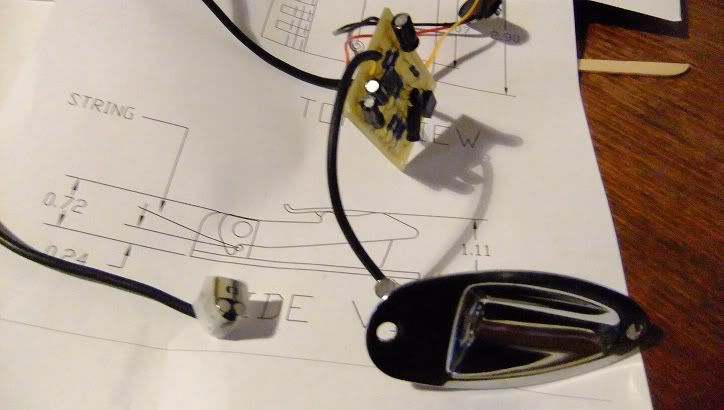 A close up below of the head with a dual magnet arrangement of different polarities which seemed to help or stop the 'wavering effect'..I thought I was being particularly clever with this approach... 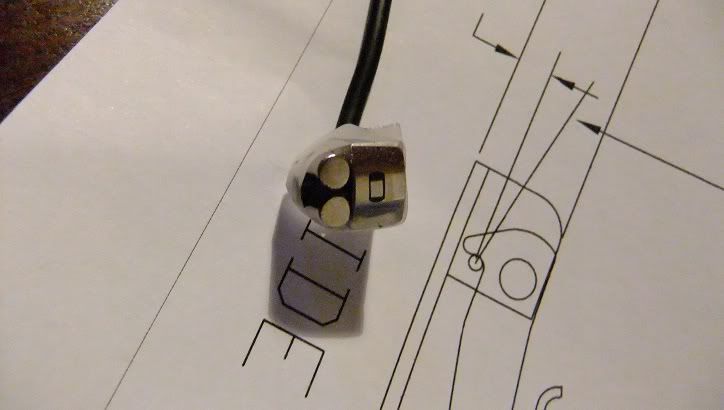 It did cure that problem, but then...hmmm ... I wondered about some of those things, some are more practical than others. I'd not want to covert the strings so if that is necessary for optics...perhaps not. I'd heard about the sting thing, but that is also a bit tricky though interesting, at least on this guitar...there are a lot of things on the project that means stings are grounded together (not the least the trilogy at the end of it!), perhaps it might be something to consider on a completely acoustic instrument where strings generally are separated on say a flat top...hmm. The capacitance thing crossed my mind, not sure I know enough about them and the problems that might emerge...if it were at all microphonic that could be a problem...but interesting if you'd like to share ideas on how that might work to pick up an individual string. The Hall effect things also came to mind, I'm not sure if this would work, but I used such a sensor in a magnet strength thing many ears ago...I might even be able to use the probe out of it which contains the sensor to do some experiments. They are tiny things. ... one could perhaps replicate the kind of HB arrangement of the GK ups...  but the impedance is about 90 ohms so very low and quite fiddly to do, a more conventional thing, as one finds in the power-gig controller illustrated on the previous page) would take a bit more winding and such, harder to keep things separated too and again a bit of work and much larger. ... So, some time to reflect and see what else might come to mind. Interesting the 'wavering' is not such a bad sound, like a light tremolo to the sound in time with the vibrations of the strings...not an 'uncool' effect. As the intention is to shadow the sound, it could even be made to work...but ultimately not what I am looking for and lots of other niggles in the system. I'm sure though I will still tinker with things over time and trials of the concept are fairly early really and hardly cost anything...so we will see... This was an additional idea that I through into the mix for this guitar and while it would be extremely cool...it is not the most important part of the concept and in truth would unlikely to be used much of the time I suspect. Weirdly, I can hear exactly what I want from the things in my head both as I play and when I hear others in this style, you know "that sounds great, but wouldn't it be cool if those bass notes were not so close in the harmony and you could get more range and separation between the low notes and the rest of the chords". It might be also that I miss my bass player, the sound of the guitar and bass duo was a good sound I have to say...I'm looking to get a similar effect on my own I guess LOL So thnaks all, more ideas and comments are appreciated, there will likely be a way that is satisfactory over time. For those inclined, these things may well work to generate a signal that could be converted to something like a midi or ADC signal, so I would not completely discount the concept should one want to explore it themselves... PS...if interested in what is in a GK divided pickup to drive roland synth things...this forum has been doing a bit of work in this area... www.vguitarforums.com/smf/index.php?topic=73.0This kind of things seems to be going a little far, but one way to get a hex signal out... www.vguitarforums.com/smf/index.php?topic=4729.0;topicseen |
|
|
|
Post by newey on Oct 28, 2011 19:19:27 GMT -5
Why are we so quick to walk away from induction? We know how to make an inductive pickup, and we know they work. Having six in a row may lead to some "crosstalk", so to speak, but the earliest synth guitars, as illustrated earlier in this thread, all seem to have used a coil over and under the strings in some fashion or other. Coils can be low impedance for a super-clean sound, and are then easier to wind as well. Another idea- if 6 individual coils (or tape heads, or capacitive system, whatever) run into size problems, how about using only 3 such sensors (whatever they may ultimately be) and have each pickup a pair of strings, E-A, D-G, B-A. The sound of the E-A strings could then be processed for a bass line. Not as versatile as being able to isolate and process each string individually, but size/fitment problems become less acute, and all the "downstream " wiring becomes easier as well. Possibly no more than a 4-conductor cable to get it out of the guitar. Just a thought. EDIT: 4real: Your latest pix are too wide, causing the screen to blow over to horizontal scrolling. If you would be so kind . . .  |
|
|
|
Post by 4real on Oct 30, 2011 17:28:30 GMT -5
pics fixeds...copied from elsewhere, did not realize the size, changed to link... ... Ah, no not at all given up on induction. Tape heads are a fairly closed system with an almost toroid structure, perhaps a true stereo version over the cheaper ones I tried may prove better, but not really designed to do what I'm trying to get from them. Winding 6 or 12 (for hb-ing) is a lot of work and in miniture likely jigs and such...so it is a bit of an investment in time and effort, but far from discounted doing that. Aside from the one shown and optical systems, that is the only 'over under' pickup system I have seen....since the original electric pickups of your...not at all ideal and would certainly get in the way of playing the thing if the strings were covered...if I am reading you right on that. I'm not too concerned about a little cross talk, it might even be inevitable, but it need not be bad and may even be possible to isolate fairly effectively. Noise might be a concern, though is single coils, they could be arranged rwrp to minimize that if used in pairs. Certainly anything is going to have to be low impedance and this guitar already has power and a fair few buffers and pre's in it, so I am not too concerned about that and want a clean sound. One might contemplate using inductors for instance as a source of pre-wound compact low impedance coils too... 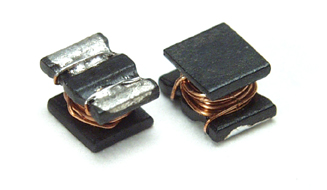 Such things are very small (these ones 4.5mm) and could be paired for HB and more output (rwrp) perhaps...basically a tiny low impedance coil, yes? Relatively cheap and manageable to play with I guess. How much pre-amplification would be required is outside my skill set of course...hmmm...but lateral thinking and preparedness to have a go is generally my forte. The intention with anything like this is to make something relatively simple and approachable, possible to DIY, cheap enough to play with and replicate. Others with more skills may run with the ideas, share them and may well become more complex to their needs and if they too share, we would all benefit. The hex thing though does seem to be the biggest obstacle from what I have seen so far. All thoughts, ideas and suggestions though are greatly appreciated and pondered though, so thanks to all. |
|
|
|
Post by 4real on Oct 31, 2011 2:13:15 GMT -5
Ok...got a little time to do a bit of tinkering with this... John Asked earlier... soundclick.com/share.cfm?id=11178958well, some program conflicts since I played with this computer recording unfortunately...but was able to record the above 'wavering' on plucked open strings. Lest one think that the tape heads were a complete failure, they do in fact 'make a sound' and not that bad except for the wavering and fairly noiseless too. The last bit used two in parallel on the same magnet (ie polarity) but wiring reversed. It may have been a little quieter in terms of noise (though this unedited clip shows that besides handling noise, there is very little) but no difference in volume from wiring another to it...so that's a good thing to know. I found another/better pre-amp to test things with... shop.aaaa-electronic.de/epages/15164820.sf/en_GB/?ObjectPath=/Shops/15164820/Products/M040it has a gain of x100 though I am running it off a 9volt battery, so that may well be reduced quite a bit though the battery is new-ish. So we all know what I am working with...here is a pic of this rig... 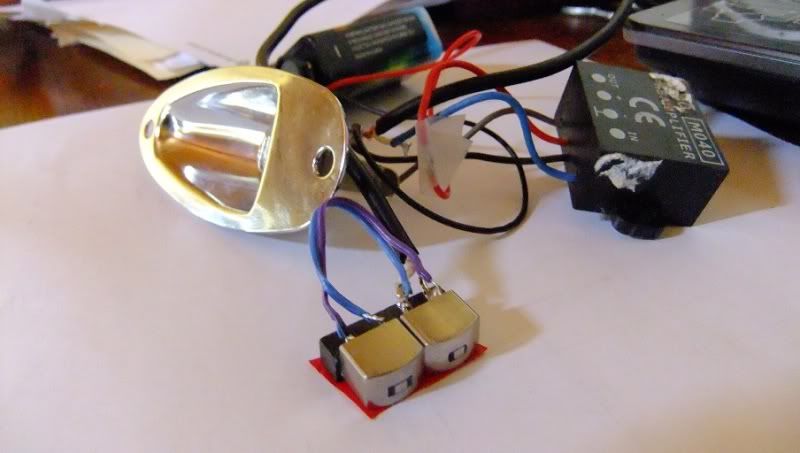 I held the Tape head with magnet over the strings 10-15mm from the bridge. This means the string has a very small arch of vibration and an overly bright sound and quick attack. I was using my strat unplugged. There is some evidence of varying pickup distance though I aimed for about 1mm...so almost touching...it will work at more of a distance but volume is further reduced, but they do need to be close (Roland's GK pickups need to be adjusted to 1mm too). They produce a louder volume and better tone of course when tested near the middle of the string. ... So, it is not that the tape heads 'don't work' as has dogged me in the past (on previous old project and at a time when audio posting was not an optionto explain exactly what is going on and what level of success. For some, even with the 'wavering' it may be fine to ascertain a pitch and amplitude trigger signal for midi in fact...but that was not really the aim for this project at this time (though I know others may well be interested in this potential. It could well be a sufficient sound for what I am aiming for, after all there will always be the guitars signal over this...but I am not really satisfied with a sound that has a permanent tremolo effect on it. I am pretty sure it is in the way these mono heads work, reading perhaps only in one direction. A stereo head might fix that as I understand they have two coils (though they might be hard to find/expensive) and the magnets might be tricky to arrange. At times it seems to waver less, the way I am testing it is a bit slap dash, the things are very sensitive so any shake in the hands trying to keep the thing at 1mm and not 1.5mm can and is heard...some of the wavering is accounted for it that, if I brace everything, it is reduced to almost acceptable levels. Moving the heads a little further from the string reduces volume but also significantly helps with the wavering effect...possibly usable with some further experimentation and a bit more pre-amplification. Alighning them a little to one side of centre might possibly help with the wavering, it's a little hard to tell without the ability to 'hard mount' them to take away human interference in the performance at this stage. I had wondered if the close proximity of the bridge pups magnets might be affecting things. I flipped the driver magnet but detected little if any difference, but not the best test. I might be able to explore things more with the project guitar or an acoustic to take that element out of the equation perhaps...but I don't think that is the case. playing with the pickups over the fretboard makes it worse, so I imagine it is the arch of vibration as much as anything...along with the coil arrangement and devices characteristics. Compared to the HB output of the strat, these things at best scenario are about 3/4 the volume of the guitar (amp setting the same). The sound clip was recorded direct into the computer with no noise reduction or effects of any kind btw... If one plays them over the 12th fret where there is a lot of string movement, the devices are much louder than the host guitar. Also, although using shielded cable, there is some handling noise of the heads and the leads I wonder if some kind of transformer would help boost the output better before it reaches the preamp? To get a decent sound in the amp (not the recording) I need to turn the treble all the way off and this should perhaps be built into the preamp system as a matter of course to get a more normal guitar sound to process (though a processor could do that itself of course. Might need some help to work out how to mod the preamp for best performance there! The noise (I'm testing things as they come to mind as I type, sorry about the disjointedness) is slightly improved by grounding the head cases (which are also serving as the magnet which is attached under them). AHHH...Just thought then, I have a pair wired rw so if I stick them together and add another mag to make a tiny HB, it is louder, better tone (wider sampling of the string) and less if any wavering...hmm...interesting...shame I don't have a 12 the same size, or even six just at the moment...might have to ger still more of the things, bugger! Not sure that that is the answer though...but it is an option I guess and an avenue to explore. ... An interesting thing I found is that you can now get a 'variax' in a rack... www.rackvax.com/ At 1,200 it is not cheap...plus you need a hex system guitar...hmmm My intention is similar to the variax in some ways, but using common digital or analog effects on the output of these things. ... For comparison and not to get too tied to the one idea (ie tape heads) I just thought to try an alternative I have up my sleeve here. 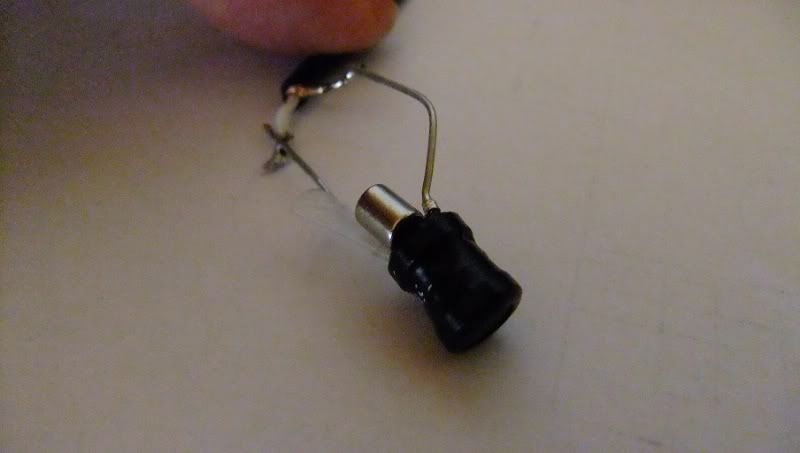 This is an inductor (or choke) on a ferrite core and a resistance of about 1 ohm I think. I stuck quiet a strong rate earth mag on the back of it...but there might be a better solution. Regardless of the strength of the magnet, little is getting through the top...interesting, might be the bobbin shape affecting things adversely compared to a normal pickup non magnetic bobbin top. This does not 'waver' (so it isn't just hand shake LOL) and a similar output to the tape heads perhaps. These things could be worth exploring more (though don't look anything as cool as a tape head and just happens to be something I had lying about). It definitely needs the magnet or there is quiet a bit of noise out of it...all these are effectively single coil pups after all...and right next to my computer and a valve amp three feet away...so noise is relative, a lot of normal strats are far worse under such conditions. Certainly if the aim is purely to get a signal from the string...these will work...so that's something right there in 5 minutes...while typing...now smaller ones in pairs perhaps would make them HB...hmmm, thinking all the time! |
|
|
|
Post by 4real on Nov 1, 2011 5:23:48 GMT -5
Been doing a bit more tinkering on this exercise...despite the horse racing carnival that 'stops a nation' and stormy weather...
So...the tape heads were not quite as good as I had hoped (though I had already ordered enough to make a matching set...in fact two...
However, from long ago in sustainer land, I have kept quite a few esoteric parts from such experiments many of which will work in reverse for such a thing as a miniature hex pup...
So devised about 6 and most of them have worked so far and I have a few other things I'd like to try too.
These things are very low impedance, so will require a bit of pre-amplification, they are also sensing the string right at the bridge so no pickup is going to put out a full power where the string movement is so little (hence bridge pups are generally stronger to compensate).
Some of them have been getting silly small...one is only 2x4x1mm plus a magnet LOL...perhaps just a little small, but did work and possibly hum cancelling too.
The one I was most taken with is effectively 6xHBs and 10x10x the string spread (say 60mm) and operated quite well 10mm from the bridge, better even further where there is still more string movement. Good separation and could potentially be made even smaller with other kinds of parts and magnets (which take up more room than the sensors, but could be smaller with rare earths). The things being HB are very quiet and I now realize that noise cancelling is vital if a lot of pre-amplification is going to be required...any noise could be amplifed 100+ fold, so don't want that!
I'm casting around for ideas as to how others might use such a device and whether to develop things further with cost and time...or to just make the one prototype out of what I have and be done with it.
Also, anyone with circuit skills who might suggest how one might go about preamp design and filtering of a bit of the highs off it...being so close to the bridge and very clean low impedance devices (less than 2 ohms per pup)...
I am wondering if it would be beneficial to run the hex pup through a transformer to 'step up' the impedance. I believe that is how lace do it with their 'single turn' alumitones ... hmmm ...or is there no advantage their when active electronics are involved anyway?
Meanwhile, bidding on an old Roland GK and synth...so there is the possibility that I might get it and use something like that anyway.
But there is something cool for my purposes in the DIY version and perhaps others might be interested in such ideas, so may as well keep exploring the possibilities.
If one were considering such a pup, what application would others be using it for, what kind of size or other specs would one desire, what kind of outputs would such a thing be realistically used for...that kind of thing.
On my project, being an arch top, I have a bit of space to play with from the top to strings (over 20mm) and as these things are getting smaller, am now considering having the hex pup mounted to a novel outrigger on the bridge itself (screwed in so removable)...I'd apply the same method for a roland.
If I were to go with a 'synth' I might hack the controller to make something internal out of it and use ideas like the thumbwheel pots and miniature momentary switches in the F holes for control...though there is every possibility that I ight save it as something that I could apply to other guitars...have to see if it can in fact do what I might hope musically, or if the original digital processing plan is more appropriate.
I've not yet worked out how to connect the guitar with three pickup systems to the outside world effectively and reliably. I do have a 4 core quality mic cable about, but what kind of connection is still up in the air for it...
|
|
|
|
Post by 4real on Nov 7, 2011 4:10:12 GMT -5
Still awaiting parts for this concept that is quickly evolving from 'hacked' tape heads to a really unique new and very small pickup design. The more I think of the design, the more applications I can see for the things/thing.
On my current project, the hex or 'divided pup' will be an optional extra output that will allow separate processing of selected strings by miniature switches built into the pickup assembly itself.
I think that these things could be used to great and simple effect as a sole or auxiliary pup on something like an acoustic guitar, mounted near the bridge or by the soundhole. They are light and compact and low impedance and could be run in stereo with a similar switch system to send selected strings to different outputs for instance.
Similar applications could be made in an electric guitar and perhaps even built into an HB enclosure with a rail pup or similar next to them to provide a divided output in various forms.
So, the design work in the background on these things is working out how to enclose these things while i wait for parts. The enclosure, like with the sustainers of a similar type, are an integral part of the design. Likely set in epoxy into a solid block.
I am still thinking to build each string driver separately with two wire leads each to be arranged perhaps on perf board as required. The first real prototype for this guitar though is likely to be a complete unit.
Internal wiring needs to be miniaturised and while not applicable to this installation, a 6 core shield cable significantly small (such as Roland use on their GK's may be required. As the initial application is mono, I can get some pretty small stuff for that...internal wiring will be done I suspect with enamelled wires, unless I use a strip-board or similar.
So, no progress other than planing stuff while waiting for parts at the moment. I have abandoned going down the whole roland GK/synth route. Demand fro second hand units seems fairly high and the systems look like not being able to do exactly what I want it to do, cost a lot and have quite a few down sides like latency and a lot of equipment to drag around.
The system as I originally conceived has little of that, no latency and uses normal digital process for the effects and basic pre-amping and wiring for the outputs. Each application would have different requirements, but mine at first will be mono and so I suspect a simple preamp will be all that is required in this case.
|
|
|
|
Post by JohnH on Nov 7, 2011 4:28:10 GMT -5
Pete - so Im hearing that tape heads are out, and the current thoughts are based on small low-impedance coils, with magnets, and that the first amplication is just to get a mono signal, not six seperate ones?
If so, I reckon I'd suggest wiring all the coils you need in series, so that outputs are added, then see if feeding that directly into a mic preamp gets you a good signal. Im sure you have some kind of mic preamp or mixer around. If it does provide a good signal with a mic preamp, we can find you a mic circuit that you can build into the guitar. If it turns out to be still too weak however, and can only get up to level with high gain and addition of excess noise, then a transformer can be added.
John
|
|
|
|
Post by 4real on Nov 7, 2011 5:49:55 GMT -5
Thanks john, great to have you making encouraging suggestions and have my back to some extent on the nitty gritty of circuitry. I have a few preamps for testing, on the test versions there is about 1/2 the output with a generic preamp oabout 100x amplification (think it is a simple KEMO thing, probably just an op-amp design. I will also be testing the ubiquitous PreCHAmp things which will allow some modification to things like gain....at least for starters. The test things were made from left over scraps brom the sustainer project things, and so are an extraordinary low impedance as meant for a completely different function (more like a speaker at about 8 ohms all chained together). By altering the design and gaining impedance I hope that this will give far more power and less of a noise potential from having to over amplify. Oh...in testing these things, and about 6 different strategies, all were done as a single string compact pickup. So, nothing to chain together at this stage. Mainly a 'proof of concept and narrowing down which direction I should take and running with that. All produced a signal, but not all had the potential I was looking for, for the whole concept and wider applications. The basic format will be similar in size to Rolands GK but working a radically different way. I am not too keen on running everything is series, perhaps I am missing something. The concept is generally to run one or two, perhaps three only at any one time. In series, there could be some radical changes in volume would there not? I suspect parallel would be a lot easier to arrange and use for this particular application. For a true hex device with separate string outs, which I know some are very interested in, they must be able to work as a separate independent single string pickup with low-no cross talk...so working on that assumption too. Because of the pre-amping required, I anticipated the noise potential and realized that the design I would need to follow would need to be effectively hum rejecting so opted for a paired design, similar in concept to an HB in some ways, in series to also increase impedance from the sustainer drivers they are based on from 2004. Transformers may well be a good thing to try, perhaps they could be run passively...the Lace Alumatones are effectively a 'single turn' coil with a transformer in it after all. ... There were a lot of problems with the 'tape head' idea. The heads I was trying were an appropriate size and cheap, but they are such a 'closed' system, virtually a toroid with a small gap, that the strings would need to virtually touch. The output was extremely low and arranging magnets tricky for best effect. They certainly did require magnifying...no signal at all without them. The too required a lot of amplification...though were reasonably quiet...adb then of course, that wavering...hmmm. The concept could work, if one could get a true stereo head. The good one I use in the car has such a head, so effectively two of these things in one. A little big (11mm wide) and hard to get cheap...hence abandoning that strategy and exploring others. A pair could perhaps address the wavering too, but I can't see them as a preferred option any more...learnt a bit though in the process though, refined the outcomes required and prep-ed for alternative solutions...so not an entirely wasted nor expensive exercise as a first go at the 'problem'. ... The new strategy is low impedance, and in miniature. I am trying to match the size of Roland's GK units perhaps but with a bit more flexibility. I've read up a bit on them and they do have their flaws and susceptible to damage. My approach is not to wind miniature HB coils as that device, but the outcomes should be similar I suspect, or at least that is the aim. Conceivably I can see these things being even smaller and there is the possibility of building them into a slightly oversized HB ring even  They do need to be mounted fairly close to the string...but nothing like that of the tape heads and worked a bit of a distance away. How the 'prototype' of the new version reacts with a different and more miniature magnet array is yet to be assessed. Where string separation is paramount, closer is better and you will obviously get the most string energy in. Part of the reason for an exceptionally low output on any of these things is entirely down to being so close to the bridge and thus end of the string. At the bridge itself of course there is no vibration, a 'zero point'. 1cm forward is full of complex harmonics, but still very small fundamental physical vibration. Low physical movment means a sensitive sensor. Used further up the string, say near the neck, and you get quite a powerful output...but that is generally not the idea for these devices which will always need to be near the string and are likely (especially if desiring a true hex output) require fairly sensitive aligning of things. So yes, good advice. Much as I did with the sustainer project, play to my strengths and try and keep things simple and cost effective. Obviously I know a bit about circuitry, but not confident or enough to get to elaborate...nor do I think that is required. The aim therefore is to work on a bit of lateral thinking and testing and a 'wish list' of criteria to get a pickup that can work on it's own or in combination with simple and compact circuitry. Much to the frustration of many, with the sustainer project I still only state that the driver design will work with a variety of generic poweramps, buffered against loading, and able to run off of a battery. That is a DIY project and that is exactly what the eBow patent states (even though it is known to be an extremely basic unbuffered LM386 design inside it) and much of which the basic idea was modelled on. The hex sustainers was something else again, and it was clear that no one could replicate what I was doing and something was required that others could build and develop further. These things are not going to really be a DIY prospect in of themselves and likely to hold on to their 'secret' for lack of the resources to protect it. The important thing is that they work, not so much how they work. Hex Sustainer's are far harder to do, making something that can sense a string quite less of a demand, so fairly confident that I am on the right path...will see in a few weeks I guess. I believe they will be cost effective to make once things are ironed out. However, the components need to be bought in some bulk just to test them and making something that small, an essential element of the design, and moulding everything in epoxies (also an important element for them to work) is beyond effective DIY. However, once the things exist and the jigs and such are made, then replicating them here is not out of the question. It is still early days and perhaps seems a bit preliminary. I am certain because I am tenacious about these things that at least I will have a working solution to what I want to do, but I can see that this is something that has enormous potential if a) it works and is cost effective and b) available to people to develop applications for them. Even in their most basic form I believe that they could have a lot of interesting uses with very little circuitry involved and nothing 'fancy' required. If running as a full hex thing, you would need 6 pre's and this could be a problem with space and outputs and the like, probably breakout boxes, multi-core leads...or do the variax thing and try and get your processing built into the guitar! But, even in a very basic application there could be quite a few possibilities. Once could potentially see an on-board 'hex-fuzz' perhaps or stereo 'split' system (distortion on lower strings, clean on top...for instance). Once out of the guitar, even with a basic system like I am proposing or a stereo version, there is unlimited potential using common and cheaply available modelling pedals or other effects. One could perhaps use a looper to capture only the bass string for instance...all manner of things people might be interested in doing. ... Design CriteriaSo, the aim is a hum-cancelling extremely compact single string pickup that can be run together or separately and from fairly basic pre-amplification for a multitude of applications. They need also to be economical in cost and construction time and be consistent and reliable. They must have low to no adverse effects on the vibration of the string, especially as they are likely to be mounted very close to the strings to maintain separation and maximize power. They must work both singly and in combinations. They must be able to reasonably be surface mounted or used without excessive mods to existing instruments.With this kind of criteria, it can be easy to knock out quite a few options that could work...the tape heads kind of didn't cut it, but an interesting exercise along the way. You can see that with this criteria, they must be able to work independently anyway, not interact or rely on being chained in series, or one might as well make a more conventional pickup design. Of course, if the aim were to only get such signals, perhaps a piezo system as per parkers, variax, gibsons, ghost, et al is the way to go. Taking the Roland solution to similar criteria, their use of tape heads was very short lived and unsuccessful really. They soon went over to, and continue to use a tiny conventional HB pup for each string. These would be extremely tricky and time consuming to replicate. Having done some research about and a little interest, I don't know if there is any real demand for such things, but I can see that there are quite a few people wishing for their own purposes that such a thing existed. There are some Hex pickup makers about, bartiloni used to have something, most though are based on conventional designs, still require preamps, are as big as a conventional pup and don't necessarily have the separation that people desire (say, for a source to run a synth or audio2midi conversion). ... Anyway, tests of the concept encouraging, enough parts to know that they will work and reasonably quiet and room to improve things and add power and perhaps make them even smaller as well. So, definitely worth pursuing. After being tempted into perhaps just getting a GK system and looking at a synth option, I now realize that for my purposes (and for many others) this is not just overkill, can not at present actually do what I am wanting from such a device. In the absence of there being an alternative really and the GK option being expensive even second hand, there really is no alternative but to come up with something completely new that will do the task...so, we will see what emerges! |
|
|
|
Post by JohnH on Nov 7, 2011 6:03:57 GMT -5
THe thing about putting a group of them in series is that if you have one per string, then each string will contribute a full x1 signal to the whole shebang. If you put them all in parallel, you will only get x1/6 output from each string. So if you can make one mono preamp that works with a chain in series, and get the gain correct, the same circuit can be replicated with no change to get two, or three or six channels, each with three or two or one pickup
|
|
|
|
Post by 4real on Nov 7, 2011 6:28:02 GMT -5
Ah...ok... How then does a strat pickup not lose power when combined in parallel with the selector? Is there a simple way with spst switches to combine the pups in series rather than parallel? Been a long weekend and a busy day, so have not got my mind around it as an option. The original idea was thus...  The proposed switches for this project are these kinds of things... 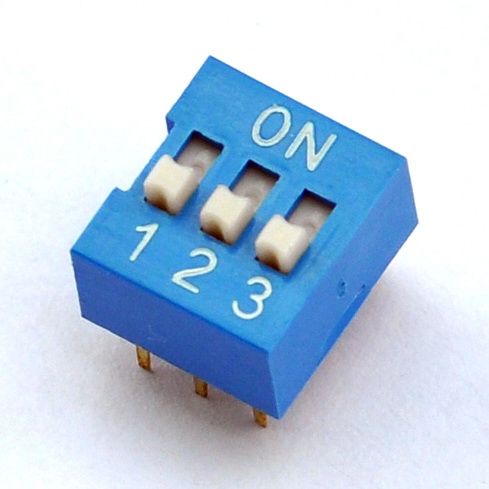 These are the most compact and for this application intuitive things to use. About the width on the pickup array, the intention is that they sit symmetrically either side of the pickup just beyond the strings to slect which of the pups are in circuit. If I try and have some kind or 'remote switching' outside of the pickup, I will need to take all six outputs through the guitar and I am hoping to avoid that. Pick-ups need to be selected in any combination. Primarily I conceived of using two or three for the bass, but I can see a lot of applications where I might want odd combinations, such as the middle strings olny with a psudo string pad 'swell' effect or even a single string with some kind of unique processing. Earlier in the year, when I was getting into "reaper" I played with a few free audio2midi software things and successfully ran quite a few VST's in mono. In a recording environment, it is entirely possible that if the bass line is recorded separately from two strings or so, it could be 'cleaned up' and be effectively, make an extremely powerful synth at no cost at all. Not the primary application of course, but points to future possibilities. ... Anyway, all help to achieve the aims is greatly appreciated, thanks...technicality noted...cheers. |
|
|
|
Post by JohnH on Nov 7, 2011 6:43:27 GMT -5
Well, in parallel wiring, you basically get an average of all the coils (setting side details such as inductance, pup position etc). In the Strat example, lets say each pickup is collecting 1x the signal from each string. Combine two such pickups in parallel and you get an average of 1x each string, in which each pickup provides x1/2 to the combined signal. Each pup has its contribution half shunted by the other, but since they both sense all strings, the combined average is two such half signal= x1. Strat pickups in parallel are approximately equally as loud as a single.
But in the proposed idea of separate pickups per string, when a string is plucked, only one coil (not all six) will detect it. You will have x1 from one coil averaged with x0 from each of the other five, ie net average = x1/6.
But if you wire them in series, all contributions are added, so x1 from each string, each from a separate coil, will add up to x1 from all strings added together.
To control such an arrangement, you could shunt each coil that you wanted off, or bypass them in a miniature 'Brian May' series wiring scheme.
|
|
|
|
Post by 4real on Nov 7, 2011 15:44:29 GMT -5
Having trouble getting my head around how to do this and looking at the BM wiring doesn't seem to help....hmmm
Might be the way I am conceiving things...so...if you wire all of the pups in series chain, if one were to shunt to ground (at least with a spst switch), or indeed 'lift' one in the chain, would this not cause a short or break in the chain so that either all would go out, or all after the non-activated pup? I am thinking of the christmas light analogy, but perhaps I am missing something there.
I can't see a more elaborate miniature switch being possible and i doubt that a bigger or outboard solution is going to be desirable for a number of reasons....hmmm
An elaboration for instance might be a 'stereo' version where such switches allow for the allocation of different pups for either channel.
It is an interesting and potentially important point that requires attention as thins develop...might have some time to test thing out but the things I have to work with just now are less than idea, I am expecting the new magnets soon though, so perhaps it will be more possible to do some tests stringing things together and maybe then I will get a clearer idea of the 'problem.
Does the 'christmas tree light' analogy not a good one and holding back my understanding, could you do a simple diagram or point to a diagram that uses such simple switching to patch in pups in series?
|
|